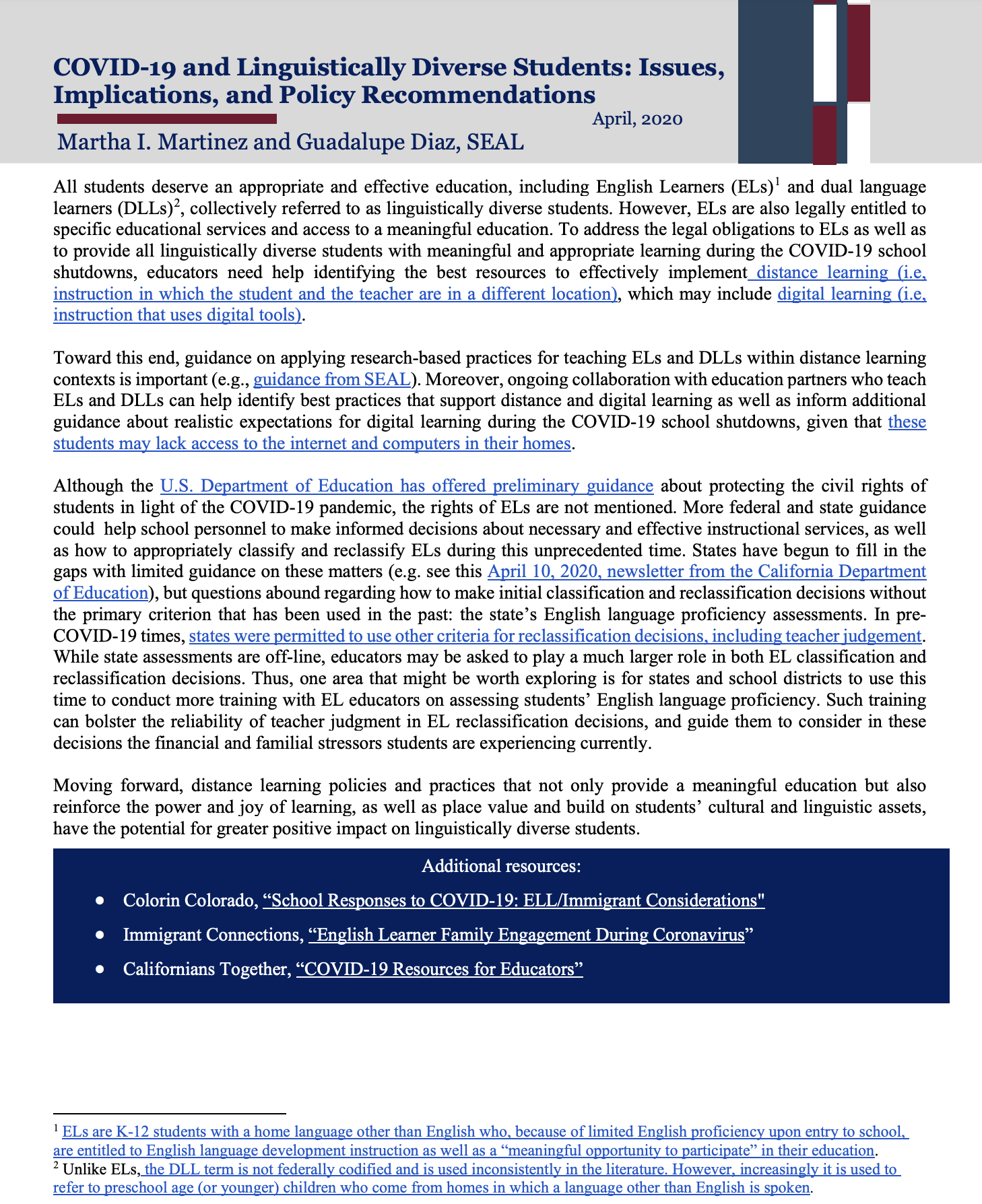
All students deserve an appropriate and effective education, including English Learners (ELs) [1] and dual language learners (DLLs) [2], collectively referred to as linguistically diverse students. However, ELs are also legally entitled to specific educational services and access to a meaningful education. To address the legal obligations to ELs as well as to provide all linguistically diverse students with meaningful and appropriate learning during the COVID-19 school shutdowns, educators need help identifying the best resources to effectively implement distance learning (i.e, instruction in which the student and the teacher are in a different location), which may include digital learning (i.e, instruction that uses digital tools).
Toward this end, guidance on applying research-based practices for teaching ELs and DLLs within distance learning contexts is important (e.g., guidance from SEAL). Moreover, ongoing collaboration with education partners who teach ELs and DLLs can help identify best practices that support distance and digital learning as well as inform additional guidance about realistic expectations for digital learning during the COVID-19 school shutdowns, given that these students may lack access to the internet and computers in their homes.
Although the U.S. Department of Education has offered preliminary guidance about protecting the civil rights of students in light of the COVID-19 pandemic, the rights of ELs are not mentioned. More federal and state guidance could help school personnel to make informed decisions about necessary and effective instructional services, as well as how to appropriately classify and reclassify ELs during this unprecedented time. States have begun to fill in the gaps with limited guidance on these matters (e.g. see this April 10, 2020, newsletter from the California Department of Education), but questions abound regarding how to make initial classification and reclassification decisions without the primary criterion that has been used in the past: the state’s English language proficiency assessments. In pre-COVID-19 times, states were permitted to use other criteria for reclassification decisions, including teacher judgement. While state assessments are off-line, educators may be asked to play a much larger role in both EL classification and reclassification decisions. Thus, one area that might be worth exploring is for states and school districts to use this time to conduct more training with EL educators on assessing students’ English language proficiency. Such training can bolster the reliability of teacher judgment in EL reclassification decisions, and guide them to consider in these decisions the financial and familial stressors students are experiencing currently.
Moving forward, distance learning policies and practices that not only provide a meaningful education but also reinforce the power and joy of learning, as well as place value and build on students’ cultural and linguistic assets, have the potential for greater positive impact on linguistically diverse students.
Additional Resources
Colorin Colorado, “School Responses to COVID-19: ELL/Immigrant Considerations”
Immigrant Connections, “English Learner Family Engagement During Coronavirus”
Californians Together, “COVID-19 Resources for Educators”
End Notes / References
- ELs are K-12 students with a home language other than English who, because of limited English proficiency upon entry to school, are entitled to English language development instruction as well as a “meaningful opportunity to participate” in their education.
- Unlike ELs, the DLL term is not federally codified and is used inconsistently in the literature. However, increasingly it is used to refer to preschool age (or younger) children who come from homes in which a language other than English is spoken.
The Research-to-Policy Collaboration (RPC) works to bring together research professionals and public officials to support evidence-based policy. Please visit their website to learn more.
Key Information
RPC Website
Research-to-Policy Collaboration
More RPC Resources
RPC Resources
Publication DateApril 1, 2020
Topic Area(s)Community-Specific, Education and Child Development, Health
Resource TypeWritten Briefs
Share This Page
All students deserve an appropriate and effective education, including English Learners (ELs) [1] and dual language learners (DLLs) [2], collectively referred to as linguistically diverse students. However, ELs are also legally entitled to specific educational services and access to a meaningful education. To address the legal obligations to ELs as well as to provide all linguistically diverse students with meaningful and appropriate learning during the COVID-19 school shutdowns, educators need help identifying the best resources to effectively implement distance learning (i.e, instruction in which the student and the teacher are in a different location), which may include digital learning (i.e, instruction that uses digital tools).
Toward this end, guidance on applying research-based practices for teaching ELs and DLLs within distance learning contexts is important (e.g., guidance from SEAL). Moreover, ongoing collaboration with education partners who teach ELs and DLLs can help identify best practices that support distance and digital learning as well as inform additional guidance about realistic expectations for digital learning during the COVID-19 school shutdowns, given that these students may lack access to the internet and computers in their homes.
Although the U.S. Department of Education has offered preliminary guidance about protecting the civil rights of students in light of the COVID-19 pandemic, the rights of ELs are not mentioned. More federal and state guidance could help school personnel to make informed decisions about necessary and effective instructional services, as well as how to appropriately classify and reclassify ELs during this unprecedented time. States have begun to fill in the gaps with limited guidance on these matters (e.g. see this April 10, 2020, newsletter from the California Department of Education), but questions abound regarding how to make initial classification and reclassification decisions without the primary criterion that has been used in the past: the state’s English language proficiency assessments. In pre-COVID-19 times, states were permitted to use other criteria for reclassification decisions, including teacher judgement. While state assessments are off-line, educators may be asked to play a much larger role in both EL classification and reclassification decisions. Thus, one area that might be worth exploring is for states and school districts to use this time to conduct more training with EL educators on assessing students’ English language proficiency. Such training can bolster the reliability of teacher judgment in EL reclassification decisions, and guide them to consider in these decisions the financial and familial stressors students are experiencing currently.
Moving forward, distance learning policies and practices that not only provide a meaningful education but also reinforce the power and joy of learning, as well as place value and build on students’ cultural and linguistic assets, have the potential for greater positive impact on linguistically diverse students.
Additional Resources
Colorin Colorado, “School Responses to COVID-19: ELL/Immigrant Considerations”
Immigrant Connections, “English Learner Family Engagement During Coronavirus”
Californians Together, “COVID-19 Resources for Educators”
End Notes / References
- ELs are K-12 students with a home language other than English who, because of limited English proficiency upon entry to school, are entitled to English language development instruction as well as a “meaningful opportunity to participate” in their education.
- Unlike ELs, the DLL term is not federally codified and is used inconsistently in the literature. However, increasingly it is used to refer to preschool age (or younger) children who come from homes in which a language other than English is spoken.
The Research-to-Policy Collaboration (RPC) works to bring together research professionals and public officials to support evidence-based policy. Please visit their website to learn more.

Key Information
RPC Website
Research-to-Policy Collaboration
More RPC Resources
RPC Resources
Publication DateApril 1, 2020
Topic Area(s)Community-Specific, Education and Child Development, Health
Resource TypeWritten Briefs
Share This Page
LET’S STAY IN TOUCH
Join the Evidence-to-Impact Mailing List
Keep up to date with the latest resources, events, and news from the EIC.




